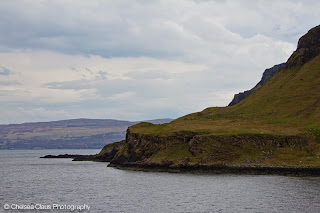What a surprising experience, we started in the morning with a clouded sky and no sun today. Maybe that’s the reason for the second name of the island. Skye is the largest island of the Inner Hebrides, about 80 km long and from 11 to 40 km broad. We arrived at Portree, the capital of the Skye, in the morning and started soon departing to the West Highlands and to the northern part, the Trotternish peninsula. Portree is nice city of around 2500 inhabitants, one fourth of the whole population.
On our tour on the Trotternish we saw the highland with the typical moorland with the heather and the gorse. In some parts they still cut the peat using it for heating; they mainly do this in May. We had a perfect view on the rock formation “Old Man of Storr”; it stands in front of the mountain ridge called Storr, rising to 1000 m above sea level. In the highlands are still some small villages and farming houses which are called croft on Skye.
The Isle of Skye is one of the youngest parts of the UK in geological meaning, only 60 million years old. So you find wonderful basaltic formations like the Kilt Rock along the coastline. We visited the Museum of Island Life, consisting of a group of small, thatched cottages.
Each presents a special rural profession and one is furnished in the style of the beginning of the 20th century. Close to the Museum village is an old cemetery where we visited the monument of Flora MacDonald who rescued Bonnie Prince Charles.
Another group drove to the south to visit the Eilean Donan Castle, one of the most-photographed castles in Scotland. Unfortunately it was under renovation and totally covered by scaffolding. But nevertheless the tour was nice passing the Cuillin Mountain Range where still were some snow on the peaks.
In the afternoon we got a lecture about “Scotland” and now we know nearly everything about the country. The evening-event was an ice-and-fruit-carving; it is really astonishing to watch how fast these guys work. 






